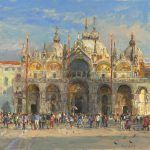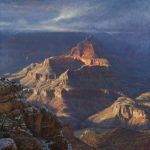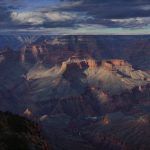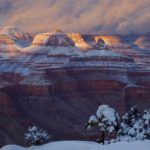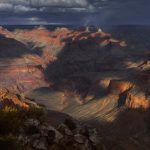Arizona painter Curt Walters lets nature and his moods inspire his work
By Norman Kolpas

Curt Walters, Beneath the Cloak of Natos, oil, 60 x 72.
This story was featured in the March 2017 issue of Southwest Art magazine. Get the Southwest Art March 2017 print issue or digital download now–then subscribe to Southwest Art and never miss another story.
On any given morning, if the weather is just right, you might find Curt Walters hopping into the car at his home in Sedona, AZ, to make the two-hour drive north to the Grand Canyon. The 66-year-old artist, who prefers to work largely in the open air but also produces pieces in his studio, has earned widespread recognition as the greatest living painter to portray the Canyon. Today, no major show of contemporary western art seems complete without a selection of his mostly large-scale, deeply immersive oils. Recently we spoke on subjects that ranged widely, from his earliest artistic experiences to how he captures his favorite subjects to his future goals and the role art plays in his life.
How did you first discover you had artistic talent? I never achieved well academically, and not until I took English 101 at New Mexico State after my senior year of high school did I finally learn that I had dyslexia. But when I was about 12, growing up in Farmington, NM, not far from the Four Corners, I found a paint set that had been given to my sister, and I discovered that art was something I could do well. I sold my first painting and won my first award at the county fair when I was 13. Painting was something I could do that no one else [around me] could. It gave me a focus. It enabled me to survive.
Why does the Grand Canyon hold such appeal for you? The first time I went there, I was 19 and had just graduated from high school in northwestern New Mexico and had my new car. My then-girlfriend and I decided to go to the Grand Canyon, and off we went. I tried painting it and was just blown away by the difficulty I encountered with its depth. It was just fascinating to me, and I’ve never gotten over it.
It’s a singular spot with so much depth, so difficult to draw, a challenge from every viewpoint. It’s so ethereal, changing its mood and character in just moments. To paint it, you have to know it really well, understand the geology and the light and the forms. It’s different than a street scene or architecture or a still life. There are simple rules for painting everything, except the Grand Canyon.
- Curt Walters, After the Catch, Puerto Penasco, oil, 20 x 30.
- Curt Walters, Crystal Rain, oil, 40 x 60.
- Curt Walters, Rendezvous at San Marcos, oil, 14 x 14.
- Curt Walters, Winter Textural Debut, oil, 28 x 28.
- Curt Walters, Ancients Unveiled, oil, 20 x 20.
What milestones stand out in your progress from novice artist to full-time professional? I never finished college. By 1973, the year I turned 23, I was pretty much making a living at fine art. But early on in that year I saw the first Prix de West show, and everyone in it was so good—it was the first time I’d seen a Wilson Hurley or Robert Lougheed or John Clymer—that it became my goal to be in it, too. So I went through a period where, year after year, I tried to paint subjects I thought were good enough to get into the show, and I have 20 rejection letters from Prix de West saying basically, “Not this year! Try again!” So I stopped trying to be in the show and began painting whatever I wanted to paint—I had shows of Bali paintings, a whole French show, another year an Italian show. And finally, in 1998, they called me up and said, “Curt, we want you in the show.” That first year, I won the Buyers’ Choice Award for a Grand Canyon painting, a great moment for me and probably my favorite award of all. And I’ve been in the Prix de West every year since.
Did you have any mentors along the way? We all need a little help along the way, and we all learn faster when we get that help. My father had done a little painting himself, and when I was a teenager he sent me to local people who painted, and they gave me informal classes. Early on, I met Lola Furman, who had studied with Kenneth Adams, one of the founders of the Taos Society of Artists. She allowed me to come over to her studio and paint with her. That was my introduction to being a professional painter. She really brought me out of my shell and taught me a lot.
Later on, when I was already making a living as an artist, I learned more about the academics of painting from Wilson Hurley. I’d go down to visit him in Albuquerque every six months, and he would critique my paintings. He would make me cry, always, and I’d walk away feeling incredibly naïve but always challenged. I really learned how to paint from him.
The other guy who had a big influence on me was Rod Goebel. He was five years older than me and totally brilliant. The most important thing I learned from Rod was to follow your intuition and paint what your heart is telling you—and also to follow the seasons, whatever is happening that day. Rod taught me that every day has its mood and you should follow the mood of that day.
Do the seasons or the mood of the day play a particular role in the process you go through for painting the Canyon? I keep an eye on the weather. I’m always hoping for those days right after a storm, when there are great cloud patterns. On a day when I think the atmosphere will be most interesting, I’ll leave in the morning to drive there. I don’t have favorite spots. I think the Grand Canyon is fascinating from every viewpoint. If I’m doing a big painting, I want car access, so I’ll normally paint the major viewpoints from the rim. I’ll work about three or four hours in the afternoon—I’m not a morning painter—and I love following shadows. A big canvas will take me about three or four days outdoors, so I’ll stay somewhere overnight. Other days, I’ll take a pochade [a compact box that contains paints, brushes, palette, easel, and canvases] and I’ll hike partway down [into the canyon] to do smaller paintings.
- Curt Walters, Awe and Silence, oil, 20 x 20.
- Curt Walters, Contradictions, oil, 20 x 30.
- Curt Walters, Evening at the Palace Gate, oil, 14 x 14.
- Curt Walters, First Touch of Winter, oil, 28 x 54.
- Curt Walters, Gilded Evening, oil, 24 x 54.
- Curt Walters, La Macarena, oil, 28 x 22.
Do you sometimes feel typecast by your best-known subject? I’m really fortunate to have been able to have a subject matter I’m identified with, and I absolutely do love the Grand Canyon. In the minds of galleries and museum shows, however, it sometimes does overshadow the other work that I do. But I’ve allowed it to, I haven’t tired of it yet, and I’m still trying new and expressive ways to portray it. And whenever I travel to other places, I still paint whatever else I want to paint.
Some people consider your paintings remarkably realistic, while others think of them as impressionistic. How do you describe your style? I’m not totally sure that I can describe it, but I think I can explain why people think that way. As you look at the body of my work over all these years, there’s a pendulum quality to it. When I’ve been painting for long periods outdoors, my style tends to loosen up and become impressionistic. Then, when I’m in the studio, my style tightens up and becomes more realistic—and that’s when I back off and go outdoors, and it becomes more impressionistic again. So my work can look like it comes from different people. But I guess my heart really lies somewhere in impressionism.
Considering your many successes, are there any goals you still feel driven to accomplish? At the age of 66, I have good health and, if I’m really fortunate, I’ll have another 20 years or so left to paint. So I really need to paint things that are important to me. There are still so many places around the world I want to visit and paint. And there are so many things about the Grand Canyon I haven’t said yet. I’ve painted all the rim views and the tourist stuff. I want to do a painting about the conquistadors and their discovery of the canyon, a subject I first became interested in when I was 24. So I’ve been collecting armor and costumes and books, and when you come in the front door of my house you walk right into my studio and see them all. There’s also so much beauty in the inner trails of the canyon and the Colorado River I want to explore. But whatever the subject, my paintings are always reflective of my emotions. I don’t make plans. There’s no formula. I just follow my instincts, always.
representation
Trailside Galleries, Jackson, WY, and Scottsdale, AZ; Nedra Matteucci Galleries, Santa Fe, NM.
- Curt Walters, Last Moments of Summer, oil, 48 x 48.
- Curt Walters, My Studio the Entrada, oil, 24 x 24.
- Curt Walters, New Snow and Evening Light, oil, 20 x 30.
- Curt Walters, Niagara Falls, oil, 42 x 90.
- Curt Walters, Spring’s Subtle Intonation, oil, 28 x 28.
- Curt Walters, Star of the Storm, oil, 60 x 50.
This story was featured in the March 2017 issue of Southwest Art magazine. Get the Southwest Art March 2017 print issue or digital download now–then subscribe to Southwest Art and never miss another story.
MORE RESOURCES FOR ART COLLECTORS & ENTHUSIASTS
• Subscribe to Southwest Art magazine
• Learn how to paint & how to draw with downloads, books, videos & more from North Light Shop
• Sign up for your Southwest Art email newsletter & download a FREE ebook








